Benjamin A. Gramm, inventor and builder of Gramm trucks. He began his first plant in 1902, and his product was a light buckboard-type with an underseat – mounted air-cooled engine and chain-drive to a "solid" rear axle.
Window to the Past
Several Patents held by Delphos area Inventors
By BOB HOLDGREVE
John Vetter, one of the original founders of the Delphos Hardware, received a patent for door locks, dated 1877.
On Feb. 26, 1885, Henry Weber of Delphos" secured a patent on a new automatic or self-returning school desk that rivals anything of the kind yet brought out. The automatic desk has a self-folding seat that moves out of the way as the pupil rises and resumes its position again as the pupil takes his seat. This improvement allows the desks to be placed six inches nearer each other. The seat is noiseless in action, neat and durable. It has been tested in our school rooms and gives perfect satisfaction. The seats will be manufactured at the Delphos Foundry, and their introduction will make it. an important industry.
Jesse Cooper of Van Wert County, was an inventor, and patented the first successful grain-drill in Ohio. In 1856 he began the manufacture of this drill at Lancaster, Ohio, which he conducted until 1864, when he moved to Van Wert County and settled on a farm.
From History of Van Wert and Mercer Counties
From, "Ohio Toolmakers" by Jack Devitt of Ottoville, we have the following inventors: George Almy of Delphos - Hollow augers, patented 1873; Ida R. Angell of Delphos - Flat iron heater, patented 1882; Wm. Berger of Delphos, a dustless ash remover; O.G. Guss - Quick adjust pipe wrenches; and John Lybarger of Delphos - patented a wood planer. Also S. Ley of Landeck invented a Force pump.
The Delphos Museum has on display an O.G. Guss wrench.
The Delphos Historical Museum has a model of steel fence posts, invented by Thomas W. Smith of Delphos, and filed Sept. 1913.
Patent serial number 791,827 (CL256.52)
Mr. John W. Ross of Delphos, patentee of the "Delphos Turbine," water wheel, who is also general agent and hydraulic engineer for the Delphos Iron Works, has just returned from Massachusetts, where he furnished a mammoth water wheel for the Montague Paper Mills, of Turner's Falls. This wheel is upon the horizontal shaft plan - four 48-inch wheels on one shaft. The shaft will be of forged iron, eight and one-half inches diameter and 32 feet long. The wheel will ran under a head (falling water) of 37 feet, and is guaranteed to give a full 1,200 horse power, perhaps the most powerful water wheel in America. The "Delphos Turbine," is now the ranking water wheel in the United States. Nearly every state and territory can boast of them in successful operation.
It is well to mention that Mr. Ross is the pioneer in the application of a turbine on a horizontal shaft, a principle in great demand by paper mills and factories.
From Delphos Herald – Feb. 8, 1877
The Delphos Iron Works received, last week, a letter from Frankfort-on-the-Main, Germany, by a citizen of that place who had personally investigated all the turbine water wheels of the country. He gives the highest praise to the Delphos wheel, and ordered several to be shipped to him. Surely, Delphos is spreading her wings.
From Delphos Herald - April 18, 1877
John Lambert of Ohio City, Ohio is said to have invented the first gasoline engine-powered automobile in the United States. The claim is validated by the Smithsonian Institute in Washington. He is also said to have over 600 patents in his name.
Situated on North Main Street is a machine and repair shop known as the Delphos Machine Works, owned and operated by Peter R. Mueller.
This industry is of great advantage to the manufacturers, mill owners and farmers, as they can have their repair work done here with neatness and accuracy.
In 1902 he added the manufacture of automobiles. With his superior knowledge of steam power, he has succeeded in perfecting a machine, propelled by steam, which is far superior to those which depend on gasoline or electricity for their motive of power. It is not subject to the, faults always found in those machines, and can be operated by anyone. He expects to increase this branch of his business and establish a factory in Delphos, second to none in the country.
From Delphos Herald - Nov. 21, 1902
A few highlights about Benjamin A. Gramm, inventor and builder of Gramm trucks and trailers by Rolland Jerry.
B.A. Gramm had a brand new plant built in Delphos in 1925 and was located there until the early 1950s, when there was a large fire there.
B.A. Gramm was born in 1872 and spent his teen years as a bank teller. But late in the 1890s he was attracted to the horseless carriage, and he had built his first one by 1900. "I can recall my first test run in the car," Gramm stated in later years, "I was out for a spin and I saw the president of the bank where I had worked. So I drove the little car slowly towards him, stopping it just as it touched his watch fob."
Gramm's boss told the crowd that he knew the car would stop. "Ben explained to me how his car worked, and he showed me the drawings, so I knew he could control and stop it," the banker said. Would that we all had bosses like that!
Gramm had his first plant in 1902, and his product was a light buckboard-type with an underseat - mounted air-cooled engine and chain-drive to "solid" rear axle. The next year, 1903, saw another novelty, a light-duty vehicle equipped with a power takeoff on the transmission.
"The power takeoff operated a clover huller and it astonished the farmers who saw it," Gramm said. "It was always my idea that the "horseless wagon would become the farmer’s best friend, " he added.
Gramm's vehicle failed to make a lasting impression, but the power takeoff feature did. He took out patents on the innovation, the first of many truck equipment items which he patented in his long career.
W.C. Cochran, Jr. has secured control of a patent plow-truck which was patented by S.W. Fleming, formerly of Delphos, now living at Van Wert. A test really proves its great utility and once used will never be dispensed with. The plow-truck consists of two iron wheels, 10 inches in diameter, separated one foot by an uptight curved iron axle.
It has been proven that two horses can do the same work with ease with the truck that it takes three horses to do without it. Mr. Cochran has placed a number of trucks on the market and is retailing them and selling territory. Anyone desiring, may see him at the National Fence Co.'s office or at Gus Grothouse's blacksmith shop.
From Delphos Herald - Aug. 17, 1893
Acetylene gas, the new illuminator, has for some time been occupying the time of inventors, and F.E. Smith, the photographer of Delphos, has been working on an improvement for the generator of the gas making machine until success has crowned his efforts. Mr. Smith gave his improvement a practical test Monday and found it to be satisfactory in every way. By his improvement, the machine is more simplified. The gas is generated from calcium carbide and water. The light is snow white and very penetrating. It is said to be even brighter than an electric light. It costs only one-half a cent to produce one foot of gas, which will burn for two hours. The machine requires charging once every two weeks and then only by the addition of carbide.
Mr. Smith will protect his improvement with a patent and place the product of his inventive genius, on the market.
The patent fire alarm invention of Klevorn and Smith of Delphos, is a grand success.
The improved fire alarm was placed on the engine house this week, and gives the utmost satisfaction to all concerned. George Stevens of Lima is general agent, and will exhibit the apparatus throughout the state.
From Delphos Herald - Oct. 16, 1879
Mr. Joseph Welch of Delphos has received a patent for a fire escape. It consists of a sheet-iron basket to carry two adults or three or four children. The basket is attached to wire ropes and can be guided from window to window, to the pavement below, or to buildings on the opposite side of the street. No danger can possibly arise in conducting persons from burning buildings. The basket is so, constructed that it can be drawn through smoke and flames, without injury to its passengers.
From Delphos Herald - June 21, 1877
Benjamin A. Gramm, inventor and builder of Gramm trucks. He began his first plant in 1902, and his product was a light buckboard-type with an underseat – mounted air-cooled engine and chain-drive to a "solid" rear axle.
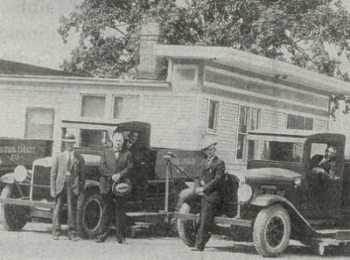
Gramm’s vehicle failed to make a lasting impression, but the power takeoff
did.
Compiled by Robert Holdgreve
Delphos Historical Society
September 21, 2002 Delphos Herald Newspaper
Landeck native Romy Williams notable inventor
As a boy, Romy Williams lived at Landeck, and later moved to Delphos. He was one of eight sons, whose father would not send them past the eighth grade. At the age of 13, Williams was running a threshing machine and blacksmith shop.
In 1913, his father bought one of the first gasoline engines, which his son converted to run a washing machine, corn grinder, butter churn and other household machines.
One of his jobs was installing D.C. light plants in Landeck. Later he "decided to run a steam shovel" when they paved South Main Street and Fourth Street in Delphos.
It was in 1924 when he opened a gas station in Landeck, that some of his major inventing took place. Williams said they called him, "Fluky," because he was always fooling around. In 1928, he became a truck tester for Gramm Trucks at Delphos. These trucks were just the chassis and engine, without a body on them. He used a crate for a seat and would drive the truck south on route 66, which at that time was a stone road.
Still later, at the request of bankers Joseph Jettinghoff and Arnold King, Williams began installing refrigerators. At first he installed make-shift home models, then moved on to commercial freezers.
One of his first inventions was an "Air-Matic
Signal," a unit with a hose across a filling station driveway, which
alerted the attendant that a customer pulled up to the pump. (A picture of this
in use is at a gas station on the northwest corner of First and Main Street.)
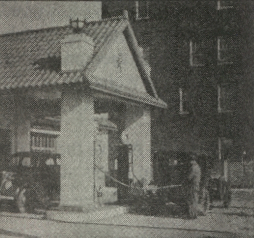
In connection with filling stations, Williams patented an additive called "Nitro-Lub-Gas," which claimed a 20 percent increase in speed, 20 to 40 percent gas and oil savings, and 95 percent of motor troubles corrected. It was manufactured in Delphos by the Williams Mfg. Co.
He also invented an electric fence, and in 1929 started to manufacture the "Williams Watch Dog," electric fence.
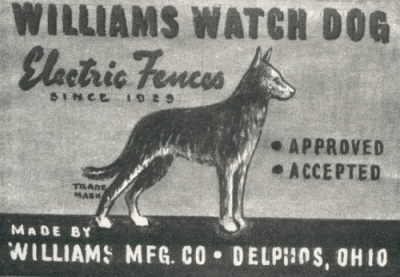
Williams bought out the Delphos Ice Machine Company which was located across the road from what is now Kill Bros., on route 697. They manufactured Ammonia Compressors, refrigerating units and ice cream cabinets. It was here also that they made the Williams Electric Fences, the Air-Matic Signals and Photo Electric Alarms.
He also invented a laser device, which he said would put a hole through a department store catalog.
Williams' other inventions include eight which he had patented and other inventions for which he never sought a patent.
One of his undeveloped ideas was a magnetic powered engine which he hoped would solve the pollution problems. Yet, when he talked to some people about a magnetic powered commuter system, he was told that in theory it wouldn't work. According to theory, a bumble bee can't fly either. (This is probably the same system that is used today on some high speed railroads, where the train is magnetically suspended a fraction of an inch above the rails. R.H.)
In the Delphos area, most people told him that the filling station device was, "just another gadget." It is still used some today. He sold this patent to some men in New York. Most of his patents were sold to speculators.
He was also seeking a patent on a, "Potato baker," and had applied for a patent on a "refrigerated milk can," that would keep the milk cool until it got to the dairy.
This information was supplied by Art Williams, a son of R.J. Williams.
Several people have said they heard that at one time, possibly during World War II, Williams had invented a device where, when a car was driving by, he could push a button and the engine would stop. We could sure use one of these today to stop the cars in police chases. I could not verify this information however. R.H.
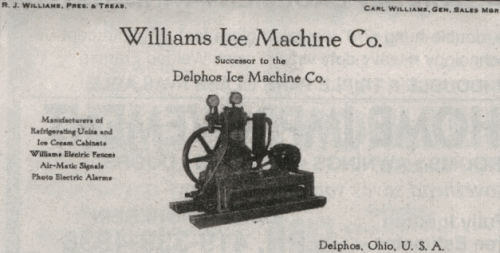
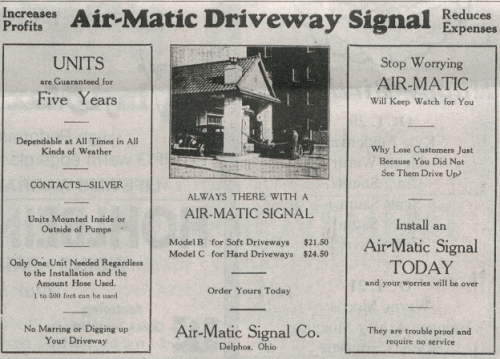
Another Landeck inventor
Thomas Gengler was born Dec. 13, 1883 in Landeck, in a log house. (A model of this log house that he made is on display at the Delphos Historical Museum.)
He was a student in a one-room country school until he was 12 years old, after which he became a farmer on his father's farm.
Tommy was an adventurous man, an accomplished athlete, musician and inventor.Members of the family thought that he could build almost anything. When his nephew Ollie Gengler wanted a radio but could not afford it, Tommy built one based on nothing more than instructions in a newspaper. Some of his projects were, a little more exotic than the radio. While the U.S. Patent Office claimed that perpetual motion is impossible, Tommy was less certain. He was an inventor and his favorite inventions were perpetual motion machines. He designed and constructed several such machines, mostly variations upon a wheel powered by falling steel balls which upset the wheel's balance, causing it to rotate, thus powering the return of the steel balls to a location where they would repeat the cycle. None of them ran perpetually, but Tommy had both hope and fun.
Compiled by Robert Holdgreve
Delphos Historical Society
October 19, 2002 Delphos Herald Newspaper